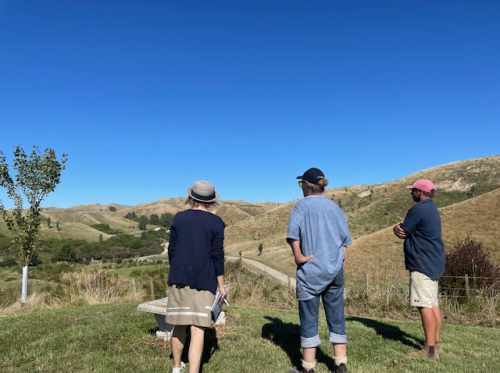
It’s 9.30 in the morning and already hot. I’m driving to visit the Clifton Cricket Club at Te Awanga Downs, where Biodiversity Hawke’s Bay’s Environmental Enhancement Contestable Fund (EECF) is helping to cover the costs of an ongoing project to plant natives around the property. These plantings will help secure sloping land, improve water quality, and enhance biodiversity.
I’m met by Matt (Fox) Nilsson, who has a huge enthusiasm for the environment he and his wife Amy are creating. The Nilssons farmed the property for 15 years, before retiring parts of it for outdoor sporting activities (archery or clay bird shooting, anyone?) and biodiversity initiatives. Moo Scotting, whose reputation as a trapping powerhouse precedes her, is also there to meet me, keen to share the wide range of trapping, monitoring, planting, and weeding tasks she does on the property.
The major aim of the project is to encourage a greater diversity and quantity of wildlife by enhancing habitat. A wide range of trees and shrubs are being planted to achieve this. Some, like Houhere, are sourced from the surrounding area, whereas others such as Kauri and Puriri are not native to Hawke’s Bay but are growing well under Moo’s watch. Kohekohe, rare in this part of the Hawke’s Bay coastline and derived from a local mature tree in Te Awanga, are also doing well.
The focus is on developing corridor plantings, linking several spring-fed lakes that are home to dabchicks, teal, and bittern. To achieve this, fencing is a key activity to exclude cattle and sheep that happily eat the native seedlings if given the chance! The results are really starting to show. Photos taken several years ago for an illustrated book provide the ‘before’ shots of a pastoral landscape, whereas today, areas of native growth of varying ages are clearly seen from the numerous hill-top lookouts. Plans are also in place for a native nursery that will enable future plants to be propagated and grown close to where they will be planted.
One plant the Nilssons are considering growing is Toetoe, a large clumping native tussock grass that provides refuge for ground-dwelling birds. Motivating this choice is the recent discovery of two kiwi in Te Awanga, outside of the predator proof fence that borders the nearby Cape Sanctuary. Whilst both kiwi were unfortunately found dead, their discovery indicates that more are likely to be present. Thus, the local people are rallying to make the area more kiwi-friendly, with two early activities being aversion training sessions for dogs and plantings to improve the habitat.
Back at Te Awanga Downs, the trapping is continuing. The key predators being caught in traps are rats, stoats, weasels and feral cats. Whilst this environmental enhancement project has been a collective effort from the start, additional neighbouring property owners are increasingly approaching Moo to place traps on their land. “Conservation is a little bit infectious!” she observes.
The EECF provides funding (between $1,000-15,000) for projects and activities that protect and enhance native biodiversity in Hawke’s Bay. It is funded by Hawke’s Bay Regional Council and managed by Biodiversity Hawke’s Bay on their behalf. “Biodiversity HB is totally on board with our vision” says Amy Nilsson “Receiving their funding was like a recognition of what we’ve been doing and what we hope to achieve.”
Looking out to the views across the Cricket Club and towards the sea, it’s easy to appreciate the beauty of the area and, with local people like Amy, Fox and their neighbours, to imagine a future in which native plants will be a much more dominant sight. For them, it’s about creating a legacy that will engage future generations, something that has already begun through the Cricket Club’s annual hosting of Outfield, an event that fuses music and arts with the wonderful natural area surrounding it.
Driving back into town, I’m smiling.

26 February 2024
Disclaimers and Copyright
While every endeavour has been taken by the Hawke's Bay Regional Council to ensure that the information on this website is
accurate and up to date, Hawke's Bay Regional Council shall not be liable for any loss suffered through the use, directly or indirectly, of information on this website. Information contained has been assembled in good faith.
Some of the information available in this site is from the New Zealand Public domain and supplied by relevant
government agencies. Hawke's Bay Regional Council cannot accept any liability for its accuracy or content.
Portions of the information and material on this site, including data, pages, documents, online
graphics and images are protected by copyright, unless specifically notified to the contrary. Externally sourced
information or material is copyright to the respective provider.
© Hawke's Bay Regional Council - www.biodiversityhb.org / 027 231 9367 / info@biodiversityhb.nz